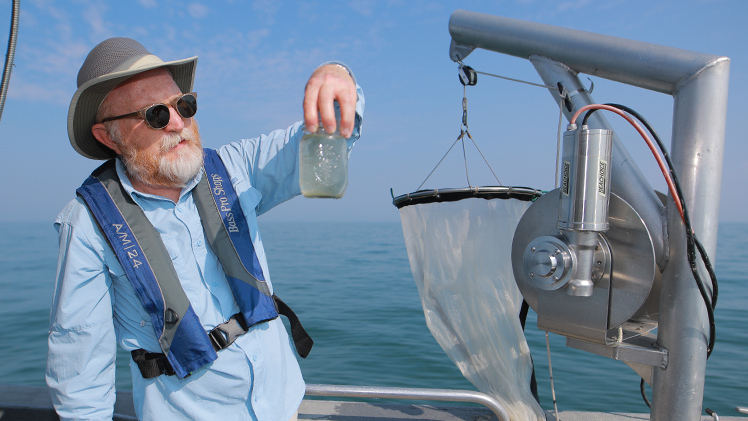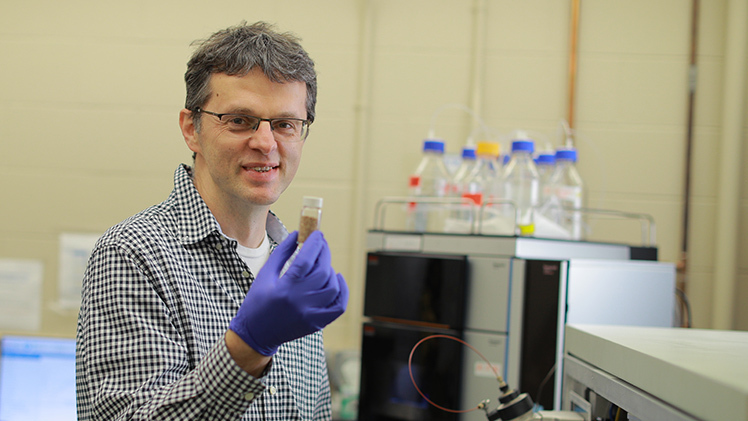The Power To Do Public Impact Research: Since a harmful algal bloom forced the city of Toledo to issue a “Do Not Drink” water advisory in 2014, UToledo has been working to protect water quality and the health of Lake Erie for the half-million people in the region who depend on it for drinking water. This is the second in a five-part series detailing UToledo’s water quality research efforts over the past decade.
On a sunny day in mid-June, Dr. Thomas Bridgeman, professor of ecology and director of The University of Toledo Lake Erie Center, was tying off a plankton tow in the stern of the R/V Spangler. He reached over the dripping net to unscrew the glass jar attached to its bottom, in which zooplankton and other biological materials that are too large to escape the fine mesh are collected. Then he held the jar up to the sunlight, peering at its contents.

Dr. Thomas Bridgeman, professor of ecology and director of The University of Toledo Lake Erie Center, and his team of staff and student researchers have been monitoring water quality in Lake Erie for more than two decades.
Pretty clear, he remarked, aside from a clump or two of what looked like wet tissue paper — the first hints of blue-green algae that would amass into a harmful algal bloom by July.
“It’s coming,” Bridgeman said.
Bridgeman and his team of staff and student researchers have been making the rounds for more than two decades in Lake Erie, monitoring water quality through parameters like water temperature, clarity, oxygen levels, turbidity and pH. The profile of their work rises annually with the emergence of a harmful algal bloom, a rapid growth of blue-green algae more accurately known as cyanobacteria that can harm people, pets and the environment.
These pea-green expanses have put locals on edge since 2014, when a bloom releasing toxins known as microcystins settled around the pipe that pulls lake water into the Toledo Water Treatment Plant, kicking off a three-day water crisis for the half-million people who live in and around Toledo.
But ten years later, thanks in part to efforts to more effectively monitor water quality and accurately predict blooms led by UToledo, locals can turn on their taps with confidence.
“Early detection has been vital,” said Edward Moore, who led the local water utility through the crisis and retired as director of public utilities with the city of Toledo in April. “We have to know what’s out there so that we’re prepared to adjust our treatment techniques. The University of Toledo been a valuable partner as we’ve updated the Toledo Water Treatment Plant to deal with any conditions out in Lake Erie.”
Advanced Research
How can we tell when a bloom is releasing toxins?
It’s a foundational question that belies any efforts to monitor and predict them, and scientists haven’t always taken the answer for granted. After Dr. Dragan Isailovic, professor in the Department of Chemistry and Biochemistry, joined the team of scientists, engineers, doctors and public health experts on the UToledo Water Task Force in the immediate wake of the water crisis in 2014, one of his first tasks was to confirm that the most widely used test for harmful algal toxins was actually accurate.
Isailovic’s research group checked its results against a more time-consuming but reliable method, liquid chromatography mass spectrometry, in partnership with collaborators at UToledo, the University of Cincinnati and Ohio State University. The work was funded under the first round of the Harmful Algal Bloom Research Initiative, which the Ohio Department of Higher Education established in response to the crisis in Toledo.
UToledo separately installed another liquid chromatography mass spectrometry system and flow cytometer in its College of Engineering in 2017, allowing local municipalities to quickly and easily test the safety of the public water supply.

Dr. Dragan Isailovic, professor in the Department of Chemistry and Biochemistry, joined the team of scientists, engineers, doctors and public health experts on the UToledo Water Task Force in the immediate wake of the water crisis in 2014.
Isailovic has continued to advance our understanding of the chemistry of harmful algal blooms from his research laboratory, where he most recently investigated how harmful cyanobacteria can grow and produce microcystins using organic nitrogen alongside collaborators at Lawrence Livermore National Laboratory, the University of Michigan and UToledo. Their research was published in The International Society of Microbial Ecology Journal.
And he continues his work to identify and catalog the many forms of cyanobacterial toxins found in Lake Erie and the Maumee River, including with a recent project under the Harmful Algal Bloom Research Initiative.
“We’ve made a lot of progress on identification and quantification of novel microcystin congeners since 2014,” Isailovic said. “When I started my water quality research in 2014, it was estimated that there were more than 100. Today we know there are more than 300.”
Sophisticated Technology
Since Bridgeman arrived at the Lake Erie Center in 2002, he and his team have hit the water nearly every week between June and September, sampling at the same sites that UToledo’s Dr. Peter Fraleigh established in the 1970s. Their old-school fieldwork supports and builds on the lab research of chemists like Isailovic, and it complements high-tech instruments in the water and in the treatment plant.
“Monitoring and predicting blooms is critical to their management,” Bridgeman said. “With advance notice water treatment plants can not only react to a release of toxins from a harmful algal bloom, but they can prepare a response that’s tailored to the specific conditions of the water. This approach both saves money and improves the taste of the water, while still providing a high level of safety.”
Sophisticated technology has been incorporated in the plant and on the water toward this end since 2014, beginning with a water quality buoy near Maumee Bay State Park that UToledo first deployed in 2015. The buoy allows for remote access to round-the-clock data on several parameters, and it quickly became part of a wider network for detecting, mapping and warning in Maumee Bay that Bridgeman established as a first-round project under the Harmful Algal Bloom Research Initiative. This network, which remains in effect, draws on sources like buoys, sensors and a public online database.
UToledo has also been hosting workshops to train researchers and water treatment plant operators in the region on how to calibrate their buoys each year since 2015.
Another example of technology applied toward monitoring and predicting harmful algal blooms is a real-time algae sensor UToledo researchers installed at a pump station in eastern Lucas County in 2022. The installation put the facility on the map as the first in the nation to test out the fluorescence-based technology that detects a pigment that flags the potential release of toxins from blue-green algal cells.
It’s part of a wider-reaching initiative aimed at the early detection and management of harmful algal blooms sponsored by the U.S. Army Corps of Engineers that’s valued at $1.4 million. Bridgeman and his collaborators recently analyzed data from the instrument in the journal Science of the Total Environment, concluding that it worked as intended during its inaugural season.
Deployed again this year in the same pump station, it’s ready for the harmful algal bloom foreshadowed by those earliest whisps of algae in June.